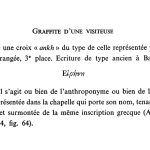| Artefact ID | 711 |
| TM ID | TM 32195 |
| Findspot (DEChriM ID) | 15 (al-Baǧawāt) | Class | Textual |
| Material | Plaster |
| Writing medium | Graffito |
| Text content | Subliterary |
| Language | Greek |
| Description | I.Oasis p. 73, no. 19; SB XX 14865; SEG XXXVIII 1716: Allegory of Peace? Name Eirene written above a crux ansata: either a name left by a visitor or rather an allegory like the one in the Chapel of Peace which is associated with the same inscription. The handwriting is ancient in Baǧawāt according to Wagner. See also the painted inscription ("peace to all") in Dayr al-Baǧawāt ID 1382. |
| Selection criteria | Christian terms/formulas/concepts, Christian symbols/gestures/isopsephy, Archaeological context associated with Christian markers |
| Date from | 275 |
| Date to | 325 |
| Dating criteria | Palaeography, parallel with the Chapel of Peace and archaeological context. Wagner suggests the end of the 3rd c. on palaeographic grounds. |
| Absolute/relative date | Relative date |
| Archaeological context | Description of chapel 23 according to Fakhry (1951: 116): No. 23 is the oldest of a group (with no. 24 and 25) in the centre of all other chapels, dominating the plain of Kharga. The facade had originally a portico of six pillars in front of it, whose ceiling was flat. Some of the holes and fragments of the sycamore logs are still preserved. The interior of the chapel has two large halls, the main burial haft was in the second one, with all the walls and columns covered with a fine layer of white plaster. When the two chapels 24 and 25 were built, new parts were added to no. 23 to connect it with them, there is even a small door which connected this chapel with no. 24. |
| Accession number | Al-Baǧawāt, in situ (Chapel no. 23 / Roquet, Ghica no. 32.09) |


 Json data
Json data




